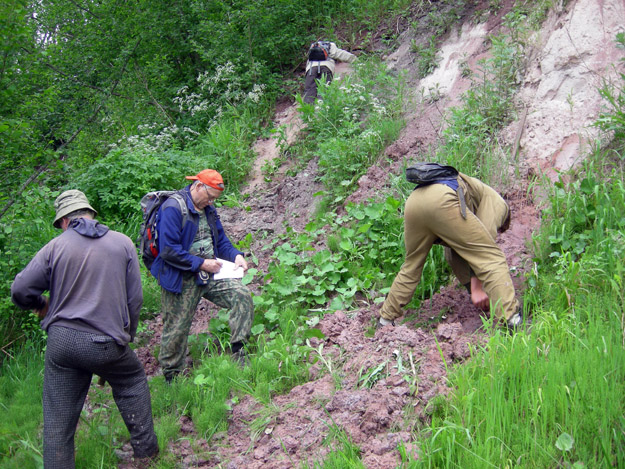LENINGRAD REGION, RUSSIA–Before I describe the usual routine we have for this fieldwork, I should note that we are in the “Leningrad Region”, which is distinct from the “St. Petersburg Region” in a formal political sense. The Leningrad Region is essentially the rural portion of Russia outside the city of St. Petersburg. The people who live here voted to retain the name “Leningrad” after the dissolution of the Soviet Union. My colleagues say these people are “more conservative” and thus include many more communists than in St. Petersburg. Interesting use of the term “conservative”, I’d say.
We rise from our finally-warm beds rather late for typical geological fieldwork, usually around 8:00 a.m. I’ve at last figured out why: the “white nights” mean we have usable sunlight until deep into the evening. We typically return to the field house at 8:00 p.m. and then begin the process of our dinner, which is usually ready by 10:00 p.m. Not quite my Wooster schedule, but I’ve adapted!
We drive to our outcrops in a 1990s Russian version of a Fiat which, although lacking most of the modern conveniences, has heated seats! (It is the only place I’m truly warm.) The roads are poorly marked, so we spend a bit of time in orientation. Since the pavements on the secondary roads — if there is a pavement — is badly potholed, we move slowly. Most of our outcrops have been on riverbanks, so we stop on the top and then climb down a nearly vertical path (inevitably lined with stinging nettles and mosquitoes waiting for that outstretched hand) to the river itself. After a geological introduction from Andrey, we scatter and explore the cliff, meeting together in an hour or so to exchange observations. Andrey knows the stratigraphy precisely, with names for units as thin as a few centimeters which correlate for hundreds of kilometers.
Mud. Mud everywhere. Every slope is slick with it, and every outcrop has its roots in brown, sticky mud. I am overly concerned with it only because I have a fixed set of clothes and no laundry possibilities for at least another week. I desperately do not want to fall in it.
Every day has had rain in it. I’m not good at predicting it here, even though the skies are extraordinarily wide above these forests. As it starts to pour that old cowboy verse comes to mind: “Cloudy in the west, looks like rain. Danged ol’ slicker’s in the wagon again.”
We do all this, of course, because the rocks are fantastic, with each exposure a puzzle to be solved, and every piece you break off shows a sight no human has seen. Scientific and historical treasures await us every day. It is also the time our diverse team bonds over common goals and wonders. No language is needed when one geologist grins and shows another a particularly well-preserved fossil, or a sequence boundary stunning in its clarity. I have the best job ever.





Pingback: Wooster Geologists » Blog Archive » A rainy day in the Mainz Basin